Related Research Articles
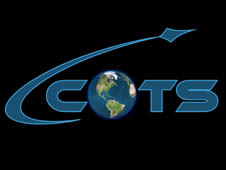
Commercial Orbital Transportation Services (COTS) was a NASA program to coordinate the development of vehicles for the delivery of crew and cargo to the International Space Station by private companies. The program was announced on January 18, 2006 and successfully flew all cargo demonstration flights by September 2013, when the program ended.
The Andrews Cargo Module was a proposed design for an unmanned resupply spacecraft which would deliver cargo to the International Space Station (ISS). Andrews Space proposed to NASA that spacecraft of this design be used for the Commercial Orbital Transportation Services (COTS) program. The proposal was ultimately rejected in favor of the SpaceX Dragon and the Orbital Sciences Cygnus.

Cygnus is an expendable American cargo spacecraft developed by Orbital Sciences Corporation but manufactured and launched by Northrop Grumman Space Systems as part of NASA's Commercial Resupply Services (CRS) program. It is usually launched by Northrop Grumman's Antares rocket from the Wallops Flight Facility, although three flights were on ULA's Atlas V and three are planned for SpaceX's Falcon 9, in both cases launching from Cape Canaveral Space Force Station. It transports supplies to the International Space Station (ISS) following the retirement of the American Space Shuttle. Since August 2000, ISS resupply missions have been regularly flown by the Russian Progress spacecraft, as well as by the European Automated Transfer Vehicle, and the Japanese H-II Transfer Vehicle. With the Cygnus spacecraft and the SpaceX Dragon, NASA seeks to increase its partnerships with domestic commercial aviation and aeronautics industry.

Commercial Resupply Services (CRS) are a series of flights awarded by NASA for the delivery of cargo and supplies to the International Space Station (ISS) on commercially operated spacecraft. The first CRS contracts were signed in 2008 and awarded $1.6 billion to SpaceX for twelve cargo Dragon and $1.9 billion to Orbital Sciences for eight Cygnus flights, covering deliveries to 2016. The Falcon 9 and Antares rockets were also developed under the CRS program to deliver cargo spacecraft to the ISS.

Orbital-D1, also known as Orb-D1, and Cygnus 1, was the first flight of the Cygnus cargo spacecraft developed by Orbital Sciences Corporation. It was named after the late NASA astronaut and Orbital Sciences executive G. David Low. The flight was carried out by Orbital Sciences under contract to NASA as Cygnus' demonstration mission in the Commercial Orbital Transportation Services (COTS) program. The mission launched on 18 September 2013 at 14:58:02 UTC. Cygnus was the seventh type of spacecraft to visit the International Space Station (ISS), after the crewed Soyuz and Space Shuttle, and uncrewed Progress, ATV, HTV and Dragon 1.

Antares A-ONE mission was the maiden flight of Orbital Sciences Corporation' Antares launch vehicle including the ascent to space and accurate delivery of a simulated payload, the Cygnus Mass Simulator (CMS), which was launched 21 April 2013. It was launched from Pad 0A at the Mid-Atlantic Regional Spaceport (MARS), Wallops Flight Facility, Virginia. The simulated payload simulates the mass of the Cygnus cargo spacecraft. This dummy payload was sent into an orbit of 240 km × 260 km with an orbital inclination of 51.6°, the same launch profile it will use for Orbital's upcoming cargo supply missions to the International Space Station (ISS) for NASA.

OA-5, previously known as Orbital-5, was the seventh planned flight of the Orbital Sciences' uncrewed resupply spacecraft Cygnus and its sixth flight to the International Space Station under the Commercial Resupply Services contract with NASA. The mission launched on 17 October 2016 at 23:45:36 UTC. Orbital Sciences and NASA jointly developed a new space transportation system to provide commercial cargo resupply services to the International Space Station (ISS). Under the Commercial Orbital Transportation System (COTS) program, Orbital designed and built Antares, a medium-class launch vehicle; Cygnus, an advanced maneuvering spacecraft; and a Pressurized Cargo Module which is provided by Orbital's industrial partner Thales Alenia Space.

OA-7, previously known as Orbital-7, is the eighth flight of the Orbital ATK uncrewed resupply spacecraft Cygnus and its seventh flight to the International Space Station (ISS) under the Commercial Resupply Services contract with NASA. The mission launched on 18 April 2017 at 15:11:26 UTC. Orbital and NASA jointly developed a new space transportation system to provide commercial cargo resupply services to the International Space Station (ISS). Under the Commercial Orbital Transportation Services (COTS) program, then Orbital Sciences designed and built Antares, a medium-class launch vehicle; Cygnus, an advanced maneuvering spacecraft, and a Pressurized Cargo Module which is provided by Orbital's industrial partner Thales Alenia Space.

OA-8E was the ninth flight of the Orbital ATK uncrewed resupply spacecraft Cygnus and its eighth flight to the International Space Station (ISS) under the Commercial Resupply Services (CRS-1) contract with NASA. The mission launched on 12 November 2017 at 12:19:51 UTC. Orbital and NASA jointly developed a new space transportation system to provide commercial cargo resupply services to the International Space Station (ISS). Under the Commercial Orbital Transportation System (COTS) program, then Orbital Sciences designed and built Antares, a medium-class launch vehicle; Cygnus, an advanced maneuvering spacecraft, and a Pressurized Cargo Module which is provided by Orbital's industrial partner Thales Alenia Space.

OA-9E was the tenth flight of the Orbital ATK uncrewed resupply spacecraft Cygnus and its ninth flight to the International Space Station (ISS) under the Commercial Resupply Services with NASA. The mission launched on 21 May 2018 at 08:44:06 UTC. Orbital ATK and NASA jointly developed a new space transportation system to provide commercial cargo resupply services to the International Space Station. Under the Commercial Orbital Transportation Services (COTS) program, then Orbital Sciences designed and built Antares, a medium-class launch vehicle; Cygnus, an advanced maneuvering spacecraft, and a Pressurized Cargo Module which is provided by Orbital's industrial partner Thales Alenia Space.

NG-10, previously known as OA-10E, is the eleventh flight of the Northrop Grumman uncrewed resupply spacecraft Cygnus and its tenth flight to the International Space Station under the Commercial Resupply Services (CRS-1) contract with NASA. The mission launched on 17 November 2018, at 09:01:31 UTC. This particular mission is part of an extension of the initial CRS contract that enables NASA to cover the ISS resupply needs until the Commercial Resupply Services-2 (CRS-2) contract enters in effect.
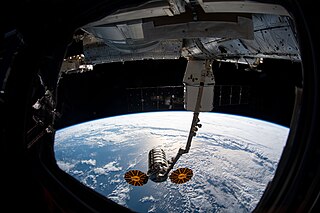
NG-11, previously known as OA-11, is the twelfth flight of the Northrop Grumman robotic resupply spacecraft Cygnus and its eleventh flight to the International Space Station under the Commercial Resupply Services (CRS-1) contract with NASA. The mission launched on 17 April 2019 at 20:46:07 UTC. This is the last mission from the extended CRS-1 contract; follow-up missions are part of the CRS-2 contract. Cygnus NG-11 was also the first mission to load critical hardware onto Cygnus within the last 24 hours prior to launch, a new Antares feature.
Jason Andrews is an American space and technology entrepreneur. He co-founded with his wife Marian Joh, Andrews Space in 1999, founded Spaceflight Inc. in 2010, BlackSky Global LLC in 2013, and integrated all three entities together in 2015 under Spaceflight Industries.

NG-13, previously known as OA-13, was the fourteenth flight of the Northrop Grumman robotic resupply spacecraft Cygnus and its thirteenth flight to the International Space Station (ISS) under the Commercial Resupply Services (CRS-1) contract with NASA. The mission launched on 15 February 2020 at 20:21:01 UTC after nearly a week of delays. This is the second launch of Cygnus under the CRS-2 contract.
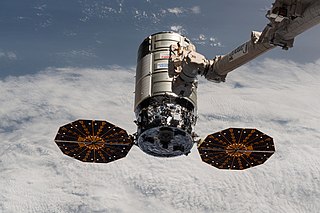
NG-14, previously known as OA-14, was the fifteenth flight of the Northrop Grumman robotic resupply spacecraft Cygnus and its fourteenth flight to the International Space Station under the Commercial Resupply Services (CRS-1) contract with NASA. The mission was launched on 3 October 2020, at 01:16:14 UTC.

NG-15, previously known as OA-15, was the fifteenth launch of the Northrop Grumman robotic resupply spacecraft Cygnus and its fourteenth flight to the International Space Station (ISS) under the Commercial Resupply Services (CRS) contract with NASA. The mission launched on 20 February 2021 at 17:36:50 UTC. This is the fourth launch of Cygnus under the CRS-2 contract.

SNC Demo-1, also known as Dream Chaser Demo-1, is the planned first flight of the Sierra Nevada robotic resupply spacecraft Dream Chaser to the International Space Station (ISS) under the CRS-2 contract with NASA. The demonstration mission is planned for launch in June 2024 on the second flight of the ULA Vulcan Centaur rocket. Sierra Nevada Corporation (SNC) developed a new reusable spacecraft to provide commercial cargo resupply services to the International Space Station (ISS), based on decades of lifting body programs. Under the Commercial Orbital Transportation System (COTS) program, SNC designed Dream Chaser with industrial partner Lockheed Martin. SNC also designed the accompanying Shooting Star cargo module with subcontractor Applied Composites. At the end of mission, the Shooting Star will destructively reenter the atmosphere and the Dream Chaser will land at the Kennedy Space Center's Shuttle Landing Facility.
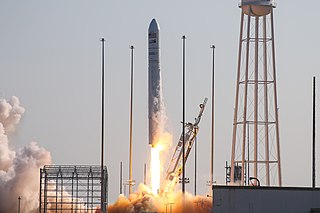
Cygnus NG-16, previously known as Cygnus OA-16, was the sixteenth flight of the Northrop Grumman robotic resupply spacecraft Cygnus and its fifteenth flight to the International Space Station (ISS) under the Commercial Resupply Services (CRS-2) contract with NASA. The mission was launched on 10 August 2021 at 22:01:05 UTC, for a (planned) 90-day mission at the ISS. This was the fifth launch of Cygnus under the CRS-2 contract.
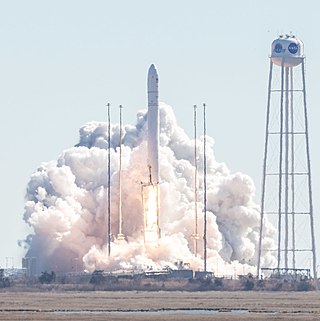
Cygnus NG-17, previously known as Cygnus OA-17, was the seventeenth flight of the Northrop Grumman robotic resupply spacecraft Cygnus and its sixteenth flight to the International Space Station (ISS) under the Commercial Resupply Services (CRS) contract with NASA. The mission launched on 19 February 2022 at 17:40:03 UTC. It was the sixth launch of Cygnus under the CRS-2 contract.
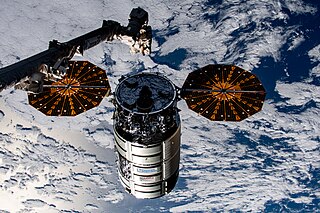
NG-19 was the nineteenth flight of the Northrop Grumman robotic resupply spacecraft Cygnus and its eighteenth flight to the International Space Station (ISS) under the Commercial Resupply Services (CRS-2) contract with NASA. The mission launched on 2 August 2023 at 00:31:14 UTC. This was the eighth launch of Cygnus under the CRS-2 contract.
References
- ↑ "Seattle Space Companies - Spaceflight Industries". Spaceflight. Retrieved 2017-01-21.
- ↑ "Andrews Space Inc: Company Profile". Bloomberg. Retrieved 2018-03-27.
- ↑ "Andrews Space – Parabolic Arc". www.parabolicarc.com. Retrieved 2018-03-27.
- ↑ "Andrews Space, Honeybee To Jointly Produce CMGs - SpaceNews.com". SpaceNews.com. 2010-07-19. Retrieved 2018-03-27.
- ↑ "Jason Andrews - Spaceflight Industries". Spaceflight Industries. Archived from the original on 2018-03-27. Retrieved 2018-03-27.
- ↑ M. Crocker, Andrew; M. Wuerl, Adam; E. Andrews, Jason; Andrews, Dana (2003-07-20). "Progress on ACES: Technology for Next Generation Space Transportation". 39th AIAA/ASME/SAE/ASEE Joint Propulsion Conference and Exhibit. doi:10.2514/6.2003-4890. ISBN 978-1-62410-098-7.
- ↑ "Andrews Space :: Corporate :: Projects". www.nanosatnews.com. Retrieved 2018-10-25.
- ↑ "Andrews Space & Technology Wins 2nd Generation Reusable Launch Vehicle Contract". Space Ref. May 21, 2001.
- ↑ Space Renaissance (2010-08-16), Gryphon Spaceplane: Flight Operations Animation @ 100 Years of Flight , retrieved 2018-10-25
- 1 2 3 theworacle (2008-12-06), Andrews Space Peregrine reusable launch vehicle, archived from the original on 2021-12-15, retrieved 2018-10-25
- ↑ Andrews, Jason (August 2012). "Spaceflight Secondary Payload System and SHERPA Space Tug". 26th Conference on Small Satellites.
- ↑ "Spaceflight Plans 2014 Demo Launch of Sherpa In-space Tug - SpaceNews.com". SpaceNews.com. 2012-05-07. Retrieved 2018-10-25.
- ↑ Andrews, Jason (August 2010). "NanoSat Deorbit and Recovery System to Enable New Missions". 25th Conference on Small Satellites.
- 1 2 "Andrews Space Wins Contract Extension from NASA". www.spaceref.com. 23 October 2003. Retrieved 2018-10-25.
- ↑ Kisliuk, Erin (2015-09-23). "COTS: Competition Rounds". NASA. Retrieved 2018-10-25.
- 1 2 "Andrews Space Wins Two DARPA FALCON Contracts". www.spacewar.com. Retrieved 2018-10-25.
- ↑ Pike, John. "FALCON Small Launch Vehicle". www.globalsecurity.org. Retrieved 2018-10-25.
- ↑ "Spaceflight Industries Awarded $250 Million USAF Contract for Reusable Booster System Ground and Flight Experiments - Spaceflight Industries". Spaceflight Industries. 2011-12-06. Retrieved 2018-10-25.
- ↑ "Andrews Space among moon ship consultants". seattlepi.com. 2008-03-18. Retrieved 2018-10-25.
- 1 2 "NASA Selects Companies for Heavy-Lift Vehicle Studies". NASA. Archived from the original on 8 November 2010. Retrieved 8 November 2010.
- ↑ "US ARMY SMDC FUNDS ANDREWS SPACE TO BUILD KESTREL EYE 2 EARTH IMAGING NANOSAT - Spaceflight Industries". Spaceflight Industries. 2013-01-31. Retrieved 2018-10-25.
- ↑ "CORTEX Avionics Complete Space Qualification - Spaceflight". Spaceflight. 2013-06-26. Retrieved 2018-10-25.
- ↑ Lindsay, Clark (2012-11-13). "Sinclair Interplanetary transfers magnetorquer manufacturing to Andrews Space" . NewSpace Watch. Retrieved 2012-11-18.
- 1 2 "Andrews Space Delivers Cargo Module Power Unit for Orbital's Cygnus Spacecraft". www.spacedaily.com. Retrieved 2018-10-25.
- ↑ "COTS 2006 Demo Competition". NASA. 2012-03-02. Retrieved 2012-11-18.
- ↑ "USAF Paves Way for Reusable Booster Demonstrator". Aviation Week & Space Technology.
- ↑ "U.S. Army Taps Andrews for Second Kestrel Eye Satellite - SpaceNews.com". SpaceNews.com. 2013-02-01. Retrieved 2018-10-24.
- ↑ "Spaceflight Industries Delivers Cargo Module Power Unit for Orbital's Cygnus Spacecraft - Spaceflight Industries". Spaceflight Industries. 2011-11-08. Retrieved 2018-10-24.
- ↑ "Spaceflight Industries to Manufacture Sinclair Rods - Spaceflight". Spaceflight. 2012-11-13. Retrieved 2018-10-24.